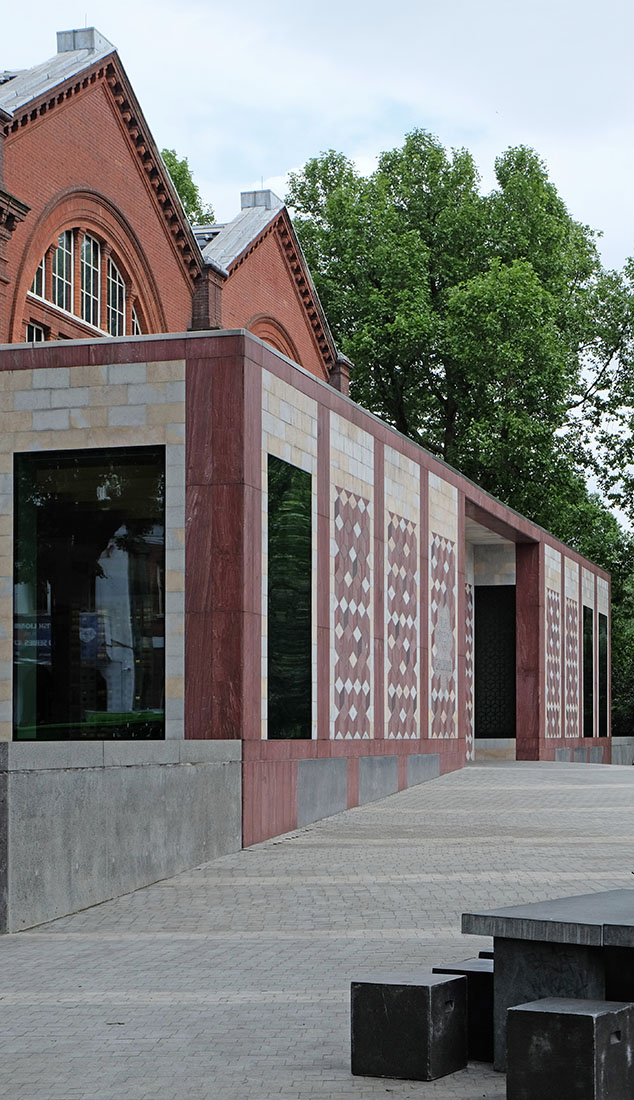 |
 |
 |
 |

Victoria and Albert Museum of Childhood
Cambridge Heath Road, London
2002 - 2007
The Museum of Childhood, part of the V&A's family of museums, is well known for the quality of its collections and for its educational activities within the East End of London. Caruso St John worked on a phased plan to improve the facilities of the building and to refresh the display of its collections. The original listed building has an extraordinary history, its iron structure was first built in west London, on the site of what is now the main V&A building, to house displays from the Great Exhibition of 1851. It was later dismantled and rebuilt with new facades in east London. A lack of funds at the time meant that the architect's full plans for the front of the museum were never carried out, leaving the building without the proper entrance and front-of-house facilities that a modern museum requires.
The first phase of improvements in 2003 concentrated on renovating the roof and ceiling, on opening up the main hall and entrance sequence, and a new exhibition display on the first floor. The second phase in 2006 completed the new collection displays, provided a new learning centre on the lower ground floor and constructed a new entrance building across the front facade of the grade II listed Victorian building. The new entrance pavilion, with its patterned elevations of red quartzite and brown porphyries, gives the Museum the formal front and outward aspect that it previously lacked.
(Text: Caruso St. John Architects)
Das Museum of Childhood, Teil der an das V&A angeschlossenen Sammlungen, ist für die hohe Qualität seiner Ausstellungsstücke wie auch seine Bildungstätigkeiten im East End von London weithin bekannt. Caruso St John arbeiteten an einem zeitlich gestaffelten Plan zur Verbesserung der Einrichtungen des Gebäudes und zur attraktiveren Schaustellung von bestehenden Sammlungen. Das ursprüngliche, unter Denkmalschutz stehende Gebäude kann auf eine bewegte Geschichte zurückblicken. Sein eisernes Tragwerk wurde ursprünglich im Westen von London an der Stelle errichtet, wo sich heute das Hauptgebäude des V&A befindet. Es wurden dort Ausstellungsstücke der Great Exhibition 1851 zur Schau gestellt. Später wurde es dann demontiert und mit neuen Fassaden im Osten von London wieder errichtet. Aufgrund mangelnder Geldmittel konnten die kompletten Pläne des Architekten für die Vorderseite des Museums nie verwirklicht werden. Damit erhielt das Gebäude nie einen entsprechenden Eingangsbereich mit den für ein modernes Museum erforderlichen Einrichtungen für Besucher.
In der ersten Verbesserungsphase im Jahr 2003 lag der Schwerpunkt auf der Renovierung des Daches und der Decke, einer Aufschließung des Hauptsaales und des Eingangstrakts und eines neuen Ausstellungsbereichs im ersten Stock. In der zweiten Phase 2006 wurden die neuen Ausstellungsbereiche fertiggestellt, ein neues Lernzentrum im Erdgeschoss eingerichtet und ein neues Eingangsgebäude an der vorderen Fassade des nach Kategorie II unter Denkmalschutz stehenden viktorianischen Bauwerks errichtet. Der neue Eingangspavillon mit seinen gemusterten Außenmauern aus Quarzit und baunem Porphyr verleiht dem Museum jene formale vordere und nach außen gerichtete Gestalt, die vorher deutlich fehlte.
(Text: Caruso St. John Architects)
